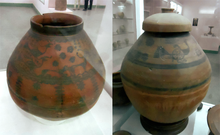Pottery of the Indus culture
The ceramics of the Indus culture (approx. 2500–1900 BC) represent their most important and best known group of objects.
As in almost all archaeological cultures, starting with the Neolithic , ceramics are the most common finds in excavations in the Indus culture . As with many other groups of objects in this culture, however, it has so far been very difficult to identify any development within ceramics. The ceramics of the Indus culture appear to us as such relatively closed. After all, it seems that painting on ceramics can be dated back to the early days. There also seem to have been regional styles and peculiarities.
technology
Most of the ceramics of the Indus culture were made with a potter's wheel , only a few forms are handmade. These include small goblets that are sometimes stamped with a short inscription. They usually have a light coating. The pottery was made in round ovens with a perforated bottom, under which the fire burned.
Painting
Most of the pottery consists of a reddish clay with a red coating. Part of the ceramic is painted. These decorations are applied in black color. The painted decoration mostly consists of horizontal lines, patterns composed of vegetable motifs are less common. Figurative representations are limited to animals such as peacocks or fish. Human figures are very rare. All decorations are heavily stylized. In addition to ceramics with a red coating, those with a light color are also often found. However, these are usually unpainted. Gray ceramics are rare. It is usually well polished, but has no coating and is never painted.
to form
The vessels usually have a flat bottom. There are the cups already mentioned, different shapes of flat and high bowls. There are tall vase-like vessels and cups. Perforated, i.e. perforated, vessels, the function of which is currently unclear, are particularly typical. Small vases with a narrow neck might contain cosmetics.
literature
- Sir Mortimer Wheeler : The Indus Civilization , Third Edition, London 1972, pp. 94-97
